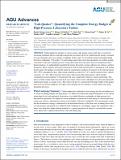“Lab‐Quakes”: Quantifying the Complete Energy Budget of High‐Pressure Laboratory Failure
Author(s)
Ortega‐Arroyo, Daniel; O'Ghaffari, Hoagy; Peč, Matěj; Gong, Zheng; Fu, Roger R; Ohl, Markus; Cattania, Camilla; Plümper, Oliver; ... Show more Show less
DownloadPublished version (14.85Mb)
Publisher with Creative Commons License
Publisher with Creative Commons License
Creative Commons Attribution
Terms of use
Metadata
Show full item recordAbstract
Understanding the interplay of various energy sinks during seismic fault slip is essential for advancing earthquake physics and improving hazard assessment. However, quantifying the energy consumed by major dissipative processes remains a challenge. In this study, we investigate energy partitioning during laboratory earthquakes (“lab-quakes”) by performing general shear stick-slip experiments on synthetic granitic cataclasites at elevated confining pressure. Using ultrasound, microstructural, and novel magnetism-based thermal analyses, we independently quantified the energy allocated to seismic radiation, new surfaces, and heat dissipation. These estimates showed good agreement with far-field measurements of mechanical work during the lab-quake. Our findings revealed that under the experimental conditions the majority of the released energy (68%–98%) is dissipated as heat, while seismic radiation accounts for 1%–8%, and the creation of new surfaces consumes <1%–32%. Microstructural observations indicate pre-failure deformation, which includes comminution and development of the principal slip zone, significantly influences energy partitioning. This effect is further evident in the measured shear stress drops, where events with higher stress drops proportionally emitted more energy as seismic waves. This study is the first to constrain the full energy budget of lab-quakes from an observational standpoint, providing critical insights into the dynamics of fault rupture and energy dissipation processes.
Date issued
2025-08-28Department
Massachusetts Institute of Technology. Department of Earth, Atmospheric, and Planetary SciencesJournal
AGU Advances
Publisher
Wiley
Citation
Ortega-Arroyo, D., O'Ghaffari, H., Peč, M., Gong, Z., Fu, R. R., Ohl, M., et al. (2025). “Lab-quakes”: Quantifying the complete energy budget of high-pressure laboratory failure. AGU Advances, 6, e2025AV001683.
Version: Final published version